Introduction
I recently purchased a 12-string acoustic guitar. I’ve always loved the full sound, but as I came to understand my wants a little better, I sold what I had (a lovely, but small Seagull Concert 12) and waited until a deal came up.
I didn’t have to wait long: a Takamine Pro guitar with all the specs I was after came available at the right price and now all I have to do is wait.
But I’m not going to talk about that today …
As you can see, a lot of VERY influential guitarists in the early 1950s and 1960s very Harmony users and fans.
At around 4:20 in the video above, we see that the acoustics were also very popular with guitarists like Pete Townshend, Jimmy Page, John Sabastian, Stevie Nicks, JJ Cale and many others.
So let’s jump in …
The Harmony 12 String Acoustic
I’ll tell you why I’m doing this deep-dive with the Harmony guitar in a minute (or you can cheat and scroll down), specifically the 12-string acoustic.
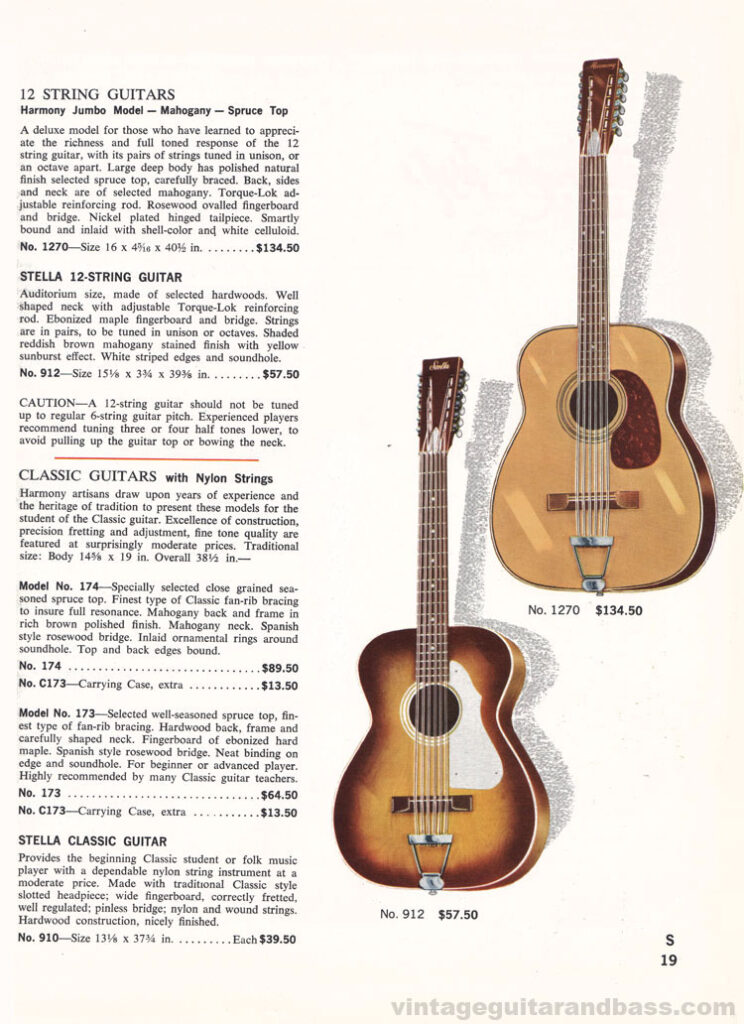
Two models of the Harmony 12 String acoustic.
Harmony was started in 1892 by Wilhelm Schultz in the United States. Schulz was a German immigrant who wound up in Chicago. The company when Schulz and a small handful of employees set up shop in the Edison Building, a location which is now Chicago’s Civic Opera House. The number of employees quickly grew to 40 just two years later
It was once the LARGEST guitar manufacturer in the US. It’s not entirely clear why their brand became so ubiquitous, but because they were based in Chicago at the time of the World’s Fair (1893) and the Windy City became a massive hub for manufacturing and distribution of things like the Sears ‘Craftsman’ home and meat products, they also probably got quite efficient with shipping a container or two of guitars across the United States. Both Montgomery Ward (also based in Chicago) and Sears advertised the Harmony guitar, sometimes for just $5.75 per item. That would be about $US 150 today.
By 1916, Sears actually purchased Harmony, but oddly enough, used the infrastructure to build ukuleles.
However, it didn’t take long to get back into the guitar-making business as upstarts like Fender and Gibson came on the scene. By 1923, Harmony was selling 250,000 units and peaked in 1965 with about 350,000 instruments, driven mainly by guitarists in the ‘British Invasion’.
The electric guitars were popular with artists like Buck Owens, Elvis, Howlin’ Wolf, Richie Valens, Jimmy Page and even in the modern era, with Dan Auerbach of the Black Keys.
Between 1945 and 1975, the Chicago firm mass-produced about ten million guitars and the company has had a bit of a resurgence of late, as a result of their new owners, BandLab. Today, most of the guitars are made in Kalamazoo, Michigan.
Mike Russo Demos the Harmony 12
Mike Russo explores some of the variations associated with 12-string guitars, using a Harmony guitar. Check it out if you’ve got a few minutes.
Background With David Delcloo
You’re probably asking yourself what’s so special about the Harmony 12-string guitar. As mentioned, lots of other guitarists have used lots of other guitars over the decades.
The answer? I feel compelled to share a personal emotional and sentimental response I had when I met a gentleman named David Delcloo in Kingston, Ontario.
I met David a few months ago when I was volunteering with Joe’s MILL. If you don’t know what they’re all about, it’s a library of musical instruments that people borrow just like books. They also lend instruments to schools and support other social events year-round.
A huge source of instruments in the library comes from donations.
David and his wife came in to donate his prized 12-string Harmony guitar. What follows are some basic answers to some questions that I tossed at him.
What’s Your Knowledge About This Guitar?
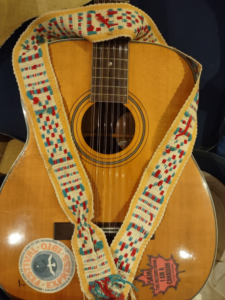
Here’s some information about the provenance of the instrument. As far I can research the Harmony is an H1270 12 String made in the mid 1960’s.
My history with the instrument: I met a chap who I knew played in Saint John, New Brunswick in early 1967 and was talking about guitars and mentioned to him that I had been looking for one and he said that he had a 12 string that he would sell. He bought the guitar From Ben Goldstein’s Music Store in Saint John, NB and that it had been stolen from his car. The insurance paid him so he bought a brand new 12 string.
Later in 1966 the police solved the case and found the stolen guitar and returned it to him.
And The Stolen Harmony Guitar Became Your Guitar?
Yes. My friend had a ‘spare’ guitar that he didn’t want and the instrument that was returned to him was in pretty bad shape.
The thieves shot pellets in the back of the guitar and wrote ” The Lepherds” on the front. The ‘Harmony’ insignia on the headstock was scratched off, but the original label inside the sound hole still confirms that it’s a Harmony.
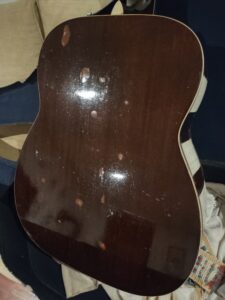
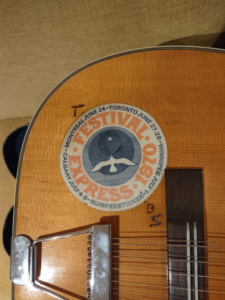
The Festival Express is a famous train trip from Toronto to Winnipeg to Calgary that a number of famous musicians took part in, including the Grateful Dead, Janis Joplin, the Band, Buddy Guy and more.
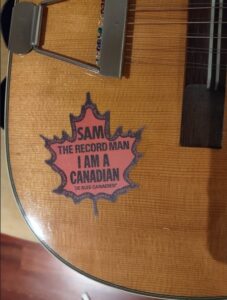
Sam the Record Man is an iconic Toronto music retailer that didn’t survive the transition of media to the digital world.
The bridge was also removed, but the music store had a replacement. I’m not a luthier (guitar builder or repair expert), but I bought some guitar shellac and put in a little time and effort to repair it. I applied a fine sanding, some wood filler for the holes and I gave it several coats of shellac. I left it to dry in our apartment, but the conditions weren’t great, resulting in small bubbles and dust remaining with the finished piece. Luthiers don’t have to fear my repair skills!
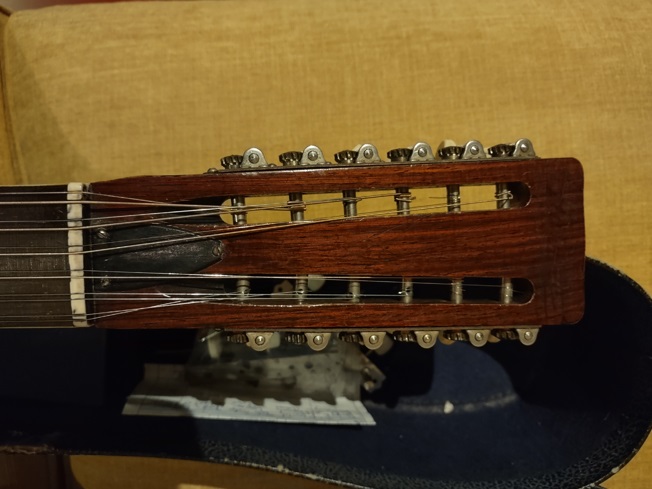
Was This Your First Guitar?
Yes. I fixed the bridge and got a new set of strings and I was excited to have a guitar that would be my crutch in attempts at folk singing. Twelve strings were all the rage at the time, with folk artists like CSNY, the Byrds, Leo Kottke and others making great use of them. My ‘new’ Harmony became my go to for learning how to strum and play chords.
What Did You Do With It From There?
I brought it to Montreal in 1968 and continued playing songs for my children. I built a song list for parties as the guitar was always popular for sing-a-longs.
My work took me across Canada and I often brought it with me. It’s been across the country, in places like Winnipeg, Edmonton and Toronto. I loved playing when traveling and most stores didn’t have a thriving rental scene, so the guitar went with me wherever I went.
I bought the stickers on the front from a record store in Montreal to hide the blemishes and ‘wounds’ that were inflicted on it. The guitar strap was belt from the Mexican pavilion from EXPO 67
From 1980 -1990, the guitar was used to entertain the Wolf Cubs group that I was in charge of. The campfires with little boys voices needed the deep sound of a 12 string to assist them.
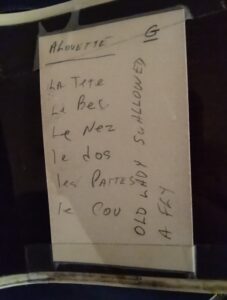
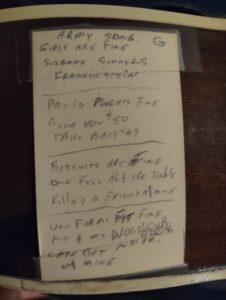
I moved to Kingston in 1991 and several years later, I had the Guitar Shop in Kingston (corner of Wellington and Clarence) replace the string mechanism and had it restrung. Since then the instrument has sat in my closet, while I wondered if I should have in repaired and try and sell it. Time is now running out and I decided that selling wouldn’t be a good idea.
A short while ago I saw something about Joe’s MILL and decided that was best way that my guitar could survive and be of use.
I am thankful the the guitar might live a little longer than I will and future generations of musicians might be able to enjoy it.
This model has been a favourite of Pete Townshend of The Who and Rory Gallagher. It has a rich tone that brings back the sounds of Leadbelly, one of the original bluesmen.
Other Performers Using Harmony 12-string
Leadbelly
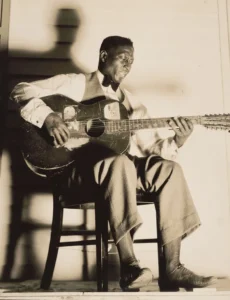
Leadbelly – born as Huddie William Ledbetter (1888-1949) – was an Louisiana-born folk and blues singer known for a strong voice, folks standards and his love of his Harmony 12-string guitar.
He could play a multitude of instruments, including the accordion, mandolin, piano, harmonica, bass and guitars (6 and 12-string).
He quit school in grade 8 and proceeded to play in ‘juke joints’.
Things for Leadbelly took a turn for the worse in 1918 when he was sent to prison for murder. He was convicted of murdering his cousin’s husband, Will Stafford. He was 33 years old at the time and spent seven years in Texas prison.
Shortly after, in 1930, he was convicted of “assault with intent to murder” in Mooringsport, Louisiana and was sentenced to six to ten years in prison.
You can read more about Leadbelly here, here and here.
Rory Gallagher
I’ll come clean and admit that I don’t know much about Rory Gallagher, but his skills and music have certainly inspired the last couple of generations of guitarists.
Here’s a taste of his music:
It’s said that when Jimi Hendrix was asked what it’s like being the greatest guitarist in the world, he answered ‘I don’t know but maybe you should ask Rory Gallagher’.
(For the record, I think that quote’s been handed around and attrivover the last six or seven decades …)
Here’s Rory with his Harmony 12-string:
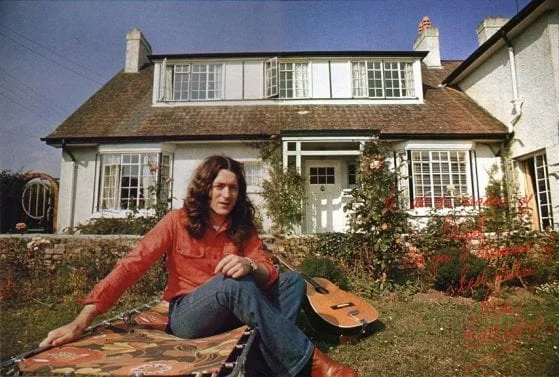
“I’ve got a 12 string Harmony Sovereign, which I use quite a lot on recordings – I had the neck taken off and put back on to get a better action.” – International Musician and Recording World, December 1976
“When the interview was over, we tried to leave his house, but he came out to the sunny garden with his Harmony 12 string in his hand. It was nice weather day. He had the complete look of one of those guitar freaked-common nice guys, you can find everywhere. When he stood behind the clear blue sky, a bit of lake flavored-sweet air and green glass in his garden, he looked totally different from a rock star who plays hard and energetically on the stage . What in the world gives this quiet, good young man has so much tough energy? …I wondered when I looked at Rory who sat on garden roller, playing a strange freakish instrumental number without any pause.” – “THE HAND BOOK” (Player Corporation) Japan, 1977
Pete Townshend
My first good guitar was an acoustic made in Prague. Later I bought a Harmony 12-string that became my staple. I was a huge fan of Leadbelly, and the Harmony was as close as I could get to his big Stella. – Acoustic Magazine
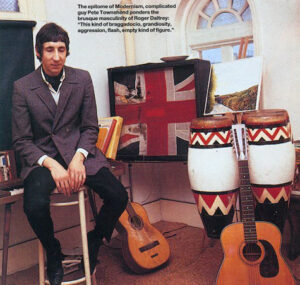
It’s hard to imagine The Who’s acoustic songs without the chime of the Harmony 12-string, including Sparks, from Tommy and Behind Blue Eyes.
The guitar was sold by Townshend in 1997 or 1998 to benefit the Maryville Academy in Chicago and it is currently owned by a private collector.
Unique features:
- Trapeze tailpiece – which allows the guitar to have very light bracing and fairly low string tension.
- Double bridge – two ivory bridges: One that the strings pass over, the other a sort of “faux bridge,” which the strings pass through.
- These features combine to give the guitar a unique, transparent sound.
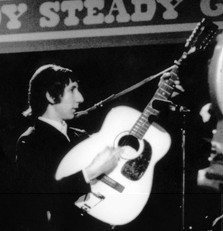
Photo: Rex Features, circa 1966, with the Harmony 12 during television performance. |
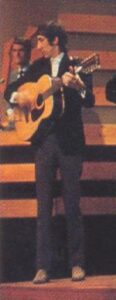
|
|
|---|---|---|
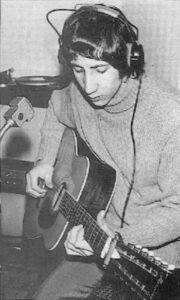
Ca. 1967, home studio, recording with the Harmony 12; C-style capo unused at the headstock.
|
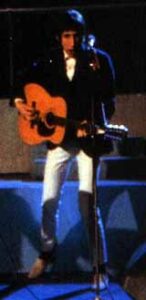 |
Gordon Lightfoot
I didn’t know that Canada’s own troubadour Gordon Lightfoot got his start with Harmony guitars. Gordon was known for using a 12-string most of his life.
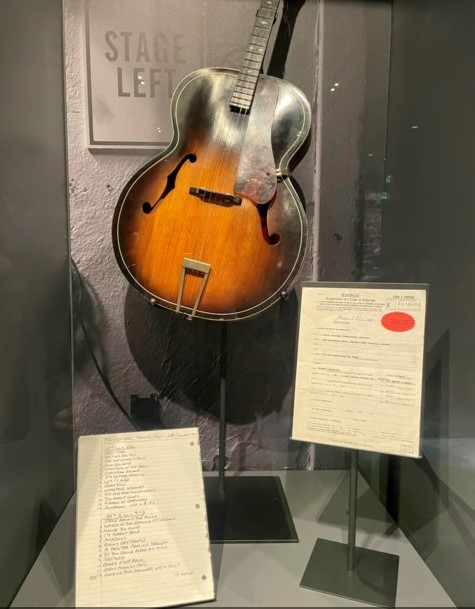
Gordon Lightfoot Harmony guitar on display at Massey Hall, Toronto
In 2024, I discovered this display case at Toronto’s Massey Hall, Gordon’s ‘home away from home’. The collection includes a reproduction of his ‘If You Could Read My Mind’ and his first guitar, a 4-string Harmony acoustic.
Other Guitarists
Both the members of the Beatles and the Rolling Stones were seen on various occasions with their Harmony 12-string guitars.
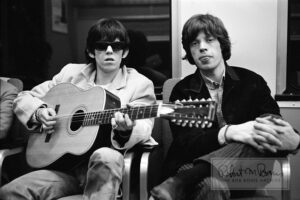
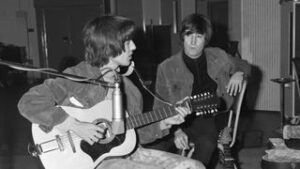
Which begs the question: who would you rather be – the Beatles or the Rolling Stones?
Kurt Cobain
Kurt’s use of the Harmony was unique, to say the least. First, he was left-handed, so he inverted his playing. However, deleted seven of the strings, leaving the five lower strings. It’s this structure that lead to low-tone drones.
He used the Harmony ‘Stella’.
Kurt bought this guitar at a pawnshop for around $30 in late 1989. It was a 12-string model, but Kurt strung it with only five nylon strings, and he allegedly never changed them since. The guitar barely stayed in tune, and apparently had duct tape holding tuning pegs in place.
This guitar was used on all of the acoustic songs on Nevermind (Polly, Something in the Way), and it supposedly even appeared on In Utero album, but only after the issues have been addressed. It was also carried regularly on tour but was mostly used just as a warm-up instrument.
A fun fact – one of Kurt’s favorite musicians, Lead Belly, played a similar guitar so that probably played some part in Kurt’s decision to buy and play this exact model.
Summary
So what is it about this act of giving that compels me to write about it? Joe’s MILL sees many instruments coming and going all the time.
Music itself is an act of giving. If you’re by yourself, it helps distract you or maybe reassure you that ideas can last for decades and maybe even forever if they’re put together well.
In fact, all of the arts are like this. Since the beginning, humans have been painting caves, singing songs, enjoying rhythms and writing while we share ideas that hopefully make us better people.
It’s in our nature to abide by the arts.
I think of David’s Harmony 12 and its long story and the people it influenced over the decades and encourage everyone out there to use their talents to inspire others.
How have certain instruments or other tools inspired you with your arts and acts of creation? Please share your thoughts below in the comments. I’d love to get a discussion going about this.
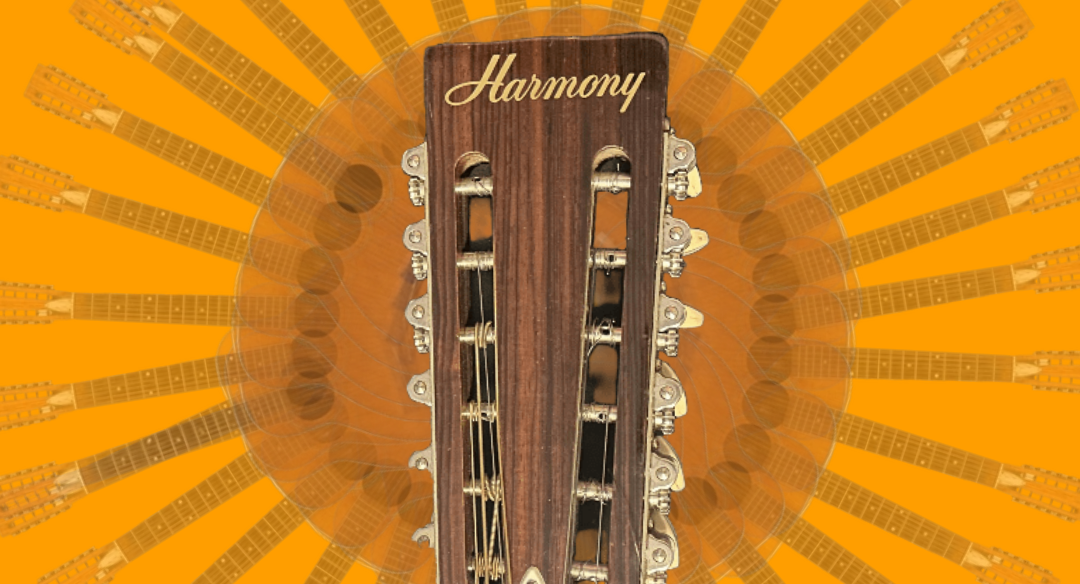
A footnote on this story – Ultimate Guitar posted a short article about Jimmy Page and his Harmony Sovereign 6-string. It was the $85 guitar that helped make the band millions, especially with Stairway to Heaven.
https://www.ultimate-guitar.com/news/gear/it-was-an-85-guitar-and-yet-it-laid-rock-musics-most-iconic-guitar-track-everyone-is-still-chasing-its-tone
Enjoy!